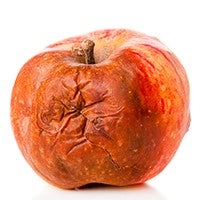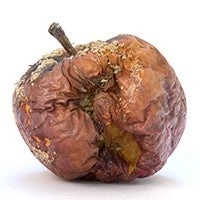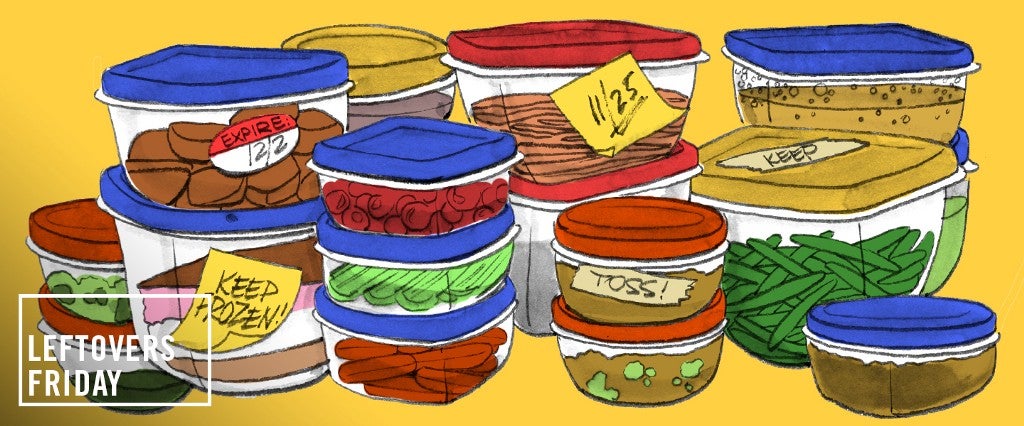Taken at their word, the USDA’s official recommendations for dealing with leftovers seem designed to scare Americans into tossing out perfectly good food. “Discard any leftovers that have been left out for more than 2 hours at room temperature,” the federal agency advises, and “leftovers can [only] be kept in the refrigerator for 3 to 4 days or frozen for 3 to 4 months.”
To the millions of Americans (like myself) who don’t think twice about eating pizza left out on the counter overnight, this is clearly ridiculous. But at the further extremes of leftoverosity, some questions do arise. Like, can you eat two-week-old turkey? Is it okay to just cut out the brown bits of the sweet potato casserole and eat the rest? And when does your one-man anti-waste crusade actually put you at risk of severe food poisoning?
Dana Gunders has answers. She’s a food scientist at the National Resource Defense Council and the author of the Waste-Free Kitchen Handbook, a common-sense guide to navigating sell-by dates, using up scraps and figuring out whether it’s safe to eat those ancient potatoes in the back of the fridge. Her golden rule, applicable to almost any leftovers situation: Trust your senses. “If it looks bad, tastes bad and smells bad, don’t eat it,” she says. “However, if it looks fine, tastes fine and smells fine, you’re probably okay.”
But all along the way — from the moment the turkey hits the table to eight months down the line, when you’re examining a half-melted chunk of pecan pie you stuck in the microwave — there are smart moves you can make to ensure that your Thanksgiving leftovers will look, taste and smell better than fine (as well as not endanger your health if you decide to chow down on them). For instance…

Immediately After Dinner (i.e., Dessert Time)
The turkey has been whittled down, huge globs are missing from the starches and everyone’s getting antsy for dessert. According to the USDA, any food that’s been sitting out for the whole meal at this point is in CRITICAL CONDITION and must be immediately refrigerated or tossed, because the harmful bacteria are about to take over. The big bad bugs like salmonella and e. coli should’ve already been killed by cooking, but lower-key pathogens like clostridium perfringens (a.k.a. “the cafeteria germ”) can partially withstand the heat and start growing as the meal cools down, then join forces with whatever Uncle Danny just sneezed all over the table.
But according to Gunders, the situation isn’t nearly as dire as the USDA would have us believe. “Most Thanksgiving food is cooked thoroughly, so the chances of having a big food safety issue even after a few hours is pretty low.”
When it comes to the turkey, this is a good argument for using a meat thermometer to make sure even the deepest part of the thigh hits 165 degrees. Most other dishes, however, get up to the bug-killing temp of 140 degrees in the normal course of cooking — the gooiness of cheddar cheese, which melts at around 150 degrees, should give you some idea of whether your dish is done.
That said, when you take out the dessert, you might as well pack up the main course and pop it in the fridge.

The Next Day (i.e., Turkey Sandwich Time)
Whether you hosted and got stuck with six pounds of uneaten turkey, or your host was kind enough to pack you multiple doggy bags to take home, you’ve got a lot of leftovers on your hands.
The USDA recommends that you throw everything out after 3 to 4 days, but Gunders says that, realistically, you’ve got about twice that long. This applies to everything — meat, potatoes, cranberry sauce, gravy, your family’s delicious regional specialty, you name it. Uncooked meat starts to get gross a lot sooner than your average apple, but once it’s tasted the transformative power of heat, all food ages at pretty much the same rate.
To make sure that nothing goes wrong, though, it’s worth reheating any leftovers back up to cooking temps (around 165 degrees), which should only take a couple minutes in the microwave.
You can also just freeze the stuff. “The smart way to go about it is to acknowledge that you’re not gonna only eat turkey for the next week, so save enough for sandwiches and freeze the rest,” Gunders advises.

A Week Later (i.e., Last Drumstick Standing)
Okay, so you didn’t freeze it, and you didn’t eat it. And to be honest, you kind of forgot that you still had a whole other Tupperware of cranberry sauce and potatoes stuck in the bottom drawer. Here’s where your nose comes in. “There’s a difference between food that’s contaminated and food that’s old,” Gunders explains. “Most people don’t want to eat old food because they think it’s gonna make them sick, but the pathogens that give you food poisoning will make you sick regardless of the food’s age.”
In other words, if your hot dogs have listeria in them fresh out of the package, or your turkey has salmonella and wasn’t cooked thoroughly enough to kill it, it doesn’t matter if you eat them immediately or after a year in the freezer. Real food poisoning — the kind that gets you sick for days, causes a fever and can even kill you — doesn’t come from rot.
Decay, on the other hand, isn’t actually dangerous; it just makes food taste kind of weird after a while. Fancy steaks, for instance, are often aged in fridge-like situations for weeks, which allows oxidation and harmless bacteria time to break down the tough bits and add some funky, nutty flavors to the meat. “However, that doesn’t mean you should eat something that’s slimy or looks or tastes weird,” Gunders says. “Our bodies are well-equipped to sense when we should no longer eat food.”
Extreme changes can mean that fungi and bacteria have taken hold, and even though the microorganisms that cause the visible effects of decay aren’t actually harmful to us, the fact that they’ve been able to spread across the food means that any legit pathogens that have hopped on or were present in only small amounts have probably proliferated.

A Month Later (i.e., Christmas)
You’re well into the holiday season, Christmas songs are playing everywhere you go, and you find a mysterious container of Thanksgiving leftovers somehow still shoved in the back of your bottom shelf. Miraculously, the food actually looks pretty good. There’s just a little bit of moldy stuff on one end. Also, you’re extremely hungry. If you just cut out the moldy bit, and maybe microwave it for 15 minutes, is it still okay to eat?
“This is where it gets tricky,” Gunders says. “For the most part, boiling or microwaving something kills most pathogens — but there are some rare kinds of fungus and bacteria that leave spores or toxins behind, so even if you kill the live pathogens, you can still get sick. If you heat it really well, your chances are a lot better, but you still can’t be sure.”
Certain types of Aspergillus mold, for instance, which like to grow on nuts and corn, can produce something called aflatoxin, which can give you liver damage or even combine with pre-existing hepatitis to trigger liver cancer. Other fungal toxins can cause kidney damage, suppress your immune system or even cause wild hallucinations and painful death (one of the prevailing theories for what caused the Salem Witch Trials hinges on mass fungus toxin-induced hallucination).
This one comes down to: Are you feeling lucky?

Two Years Later (i.e., Thanksgiving 2018)
It’s early November 2018, and you just found a frozen brick of turkey and gravy back behind the box of popsicles with the one orange popsicle left that nobody wants. And you’re hungry.
Good news: You can eat it. The USDA recommends only freezing for three to four months, but even they admit that anything frozen is “safe indefinitely.” The problem here is that it might just taste kind of gross. “If you leave things in the freezer for more than a year,” Gunders says, “the biggest problem is taste alteration — there’s freezer burn, and meat can continue to go rancid in the freezer.”
“Rancid” sounds dangerous, but really it just means it tastes bad. “A lot of the olive oil we’re using is rancid,” Gunders notes, “and most walnuts are rancid, too — it just means the fats have oxidized, and it might taste kind of bitter.”
To get around all of that rancidness, you can just chop off the freezer-burned section, pop it in the microwave and go to town. Or grin and bear the bitterness if bitterness isn’t a deal-breaker for you.
Bon appétit, people of the future!
